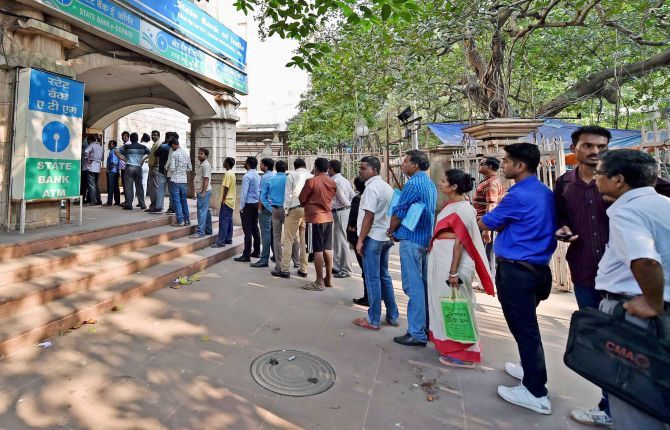
The theory that all banned notes will come back into the system may not be true.
Anup Roy/Business Standard finds out.
With the government deciding to remain silent on the exact amount that banks have received in deposits through old currency notes by now, speculation is rife that the entire money scrapped could be coming back to the Reserve Bank of India by December 30.
Therefore, questions could be raised about the utility of the demonetisation exercise itself.
The government was expecting deposits worth Rs 10 lakh crore to Rs 11 lakh crore would come back to the banking system while the rest would not be declared.
The government was hoping the undeclared part of the currency liability could, then, be transferred by RBI to the government as dividend, which could, in turn, be used to recapitalise banks or be spent in other social sectors.
According to RBI estimates, till November 27, nearly Rs 8.45 lakh crore has come back in the banking system.
While there has been no update to that number, various media publications are quoting sources as saying that Rs 11 lah crore to Rs 13 lakh crore has already come back in banks.
At this rate, by December end, the entire money can be expected to be back in the system. This will upset government math.
Understandably, many commentators have turned critical of the government and started labelling the demonetisation exercise a failure. But some economists still expect the government to gain handsomely in monetary terms.
The gain may come via unreturned money, or through higher tax collection on money previously untaxed.
State Bank of India group Chief Economic Advisor Soumya Kanti Ghosh expects Rs 2.5 lakh crore not to come back in the system.
The scrapping of high-value notes, Rs 500 and Rs 1,000, was announced by Prime Minister Narendra Modi on November 8.
The SBI research report said the market was estimating Rs 14.18 lakh crore of high-value denomination notes, while in reality, this figure was at Rs 15.44 lakh crore based on November 9 data.
Thus, Ghosh says, an increase of Rs 1.26 lakh crore, was being missed out by many. These figures do not include cash with banks, which is roughly Rs 75,000 crore to Rs 76,000 crore, Ghosh clarified.
The cash component with banks includes high value currency in automated teller machines that could not get out in the system and, therefore, got scrapped.
Similarly, money kept in the RBI's currency chests should not be included for the calculation as this money becomes the RBI's property and, therefore, gets out of circulation.
The RBI has more than 4,000 currency chests that banks use as vaults for their surplus money, as well as to maintain cash reserve ratio.
However, most of the CRR requirement is done electronically, so the amount in the currency chests might not be much even as the currency chest figure is not disclosed by the RBI.
Also, one important figure to be considered here is that banks do get regular deposits as part of their operations.
Before the demonetisation drive, the monthly deposit accretion was about Rs 60,000 crore. We need to exclude this figure, too, when we consider the total deposits in banks.
Economists and bankers also say there could be double counting.
Cooperative banks act as agents for commercial banks and the deposits they garner get into the banking channel and become part of the total deposit figure. They are also sending their deposit numbers to the government and the RBI.
Since there is no official declaration of the total deposits mobilised, the numbers floating around could include these deposits that are also counted by the banks.
But a worrying factor in this demonetisation drive is that a lot of money deposited in banks and in post offices could be fake.
Post offices and small cooperative banks are not fully equipped to distinguish between fake and original notes and banks, too, could be seeing large numbers of fake notes getting deposited considering the rush in the counters.
The fake notes, for now, could be getting counted in the deposit base, but will get sorted out by the time they reach the RBI.
For now, bankers say they are keeping the old notes in their office vaults itself and, therefore, the chances of eliminating fake notes are slim.
SBI's Ghosh estimates that around Rs 2.5 lakh crore 'on a conservative basis' will not be coming back into the system.
'Additionally, if a percentage of such unaccounted money is ultimately disclosed and taxed, this will be beneficial to the government as such taxes could be immediately factored in next year's Budget for welfare needs,' the SBI report said.
PwC India's economist Ranen Banerjee agrees with this assessment.
"Not only does the government get tax revenue, but the money so far kept out of banking system can also come back and get circulated in the economy, which will boost economic activity," said Banerjee, leader, public finance and economy at PwC India.
How much money remains undisclosed could be a matter of debate, but there would be some money that may not come back.
In the long run, that could be the tangible benefit for the government, if it manages to get the money back from the RBI to its coffers, economists say.
'Whatever be the outcome, the pie distribution will differ and we believe that taxes collected will be beneficial to the government rather than currency getting extinguished as such taxes could be immediately factored in next year's Budget for welfare needs,' SBI said.











